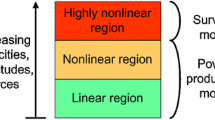Abstract
Due to their computational convenience, linear mathematical models for wave energy converters are usually employed. Including nonlinearities may improve the accuracy of the results, but often at the price of an additional computational and complexity burden, which can be justified only if nonlinearities are significant. One of the sources of nonlinearity in fluid–body interactions is the wave field itself. Different wave models exist, among which are linear Airy’s theory, Wheeler’s stretching approach, the nonlinear Rienecker–Fenton method, and higher order spectral methods, all of which achieve a different compromise of accuracy and complexity. The impact of the accuracy of such wave theories strongly depends on the specific device (operating principle, power production region or survivability mode), and installation site (water depth, occurrences of each sea state in the scatter diagram of the installation site). This paper evaluates the performance of different wave field representations, firstly in absolute terms and, secondly, in relation to the associated computation of nonlinear Froude–Krylov forces for different wave energy devices, in regular and irregular sea states. It is shown that Wheeler’s stretching offers a good accuracy/complexity compromise for WECs operating in the power production region.











Similar content being viewed by others
References
Aquamarine (2016) Aquamarine power. http://www.aquamarinepower.com/
Babarit A, Mouslim H, Clément A, Laporte-Weywada P (2009) On the numerical modelling of the non linear behaviour of a wave energy converter. In: ASME 2009 28th international conference on ocean, offshore and arctic engineering. American Society of Mechanical Engineers, pp 1045–1053
Clauss G, Kosleck S, Sprenger F, Boeck F (2009) Adaptive stretching of dynamic pressure distribution in long-and short-crested sea states. In: ASME 2009 28th international conference on ocean, offshore and arctic engineering. American Society of Mechanical Engineers, pp 333–343
Dean RG, Dalrymple RA (1991) Water wave mechanics for engineers and scientists, vol 2. World Scientific Publishing Co Inc, London
Du S, Hudson D, Price W, Temarel P (2009) Implicit expressions of static and incident wave pressures over the instantaneous wetted surface of ships. Proc Inst Mech Eng Part M J Eng Marit Environ 223(3):239–256
Ducrozet G (2017) Open-source release of HOS-ocean. https://github.com/LHEEA/HOS-ocean/wiki
Ducrozet G, Bonnefoy F, Le Touzé D, Ferrant P (2007) 3-d HOS simulations of extreme waves in open seas. Natl Hazards Earth Syst Sci 7(1):109–122. https://doi.org/10.5194/nhess-7-109-2007. http://www.nat-hazards-earth-syst-sci.net/7/109/2007/
Ducrozet G, Bonnefoy F, Le Touzé D, Ferrant P (2016) HOS-ocean: open-source solver for nonlinear waves in open ocean based on high-order spectral method. Comput Phys Commun 203:245–254
Ducrozet G, Bonnefoy F, Perignon Y (2017) Applicability and limitations of highly non-linear potential flow solvers in the context of water waves. Ocean Eng 142:233–244
Fenton J (1990) Nonlinear wave theories. Sea 9(Part A):3–25
Gilloteaux JC (2007) Mouvements de grande amplitude d’un corps flottant en fluide parfait. application à la récupération de l’énergie des vagues. PhD thesis, Ecole Centrale de Nantes-ECN
Giorgi G, Ringwood JV (2017a) Comparing nonlinear hydrodynamic forces in heaving point absorbers and oscillating wave surge converters. J Ocean Eng Mar Energy 1–11. https://doi.org/10.1007/s40722-017-0098-2
Giorgi G, Ringwood JV (2017b) Computationally efficient nonlinear Froude–Krylov force calculations for heaving axisymmetric wave energy point absorbers. J Ocean Eng Mar Energy 3(1):21–33
Giorgi G, Ringwood JV (2017c) Froude–Krylov and viscous drag representations in nonlinear wave energy devices models in the computation/fidelity continuum. Ocean Eng 141:164–175
Giorgi G, Penalba M, Ringwood JV (2016) Nonlinear hydrodynamic models for heaving buoy wave energy converters. In: Proceedings of the 3rd Asian wave and tidal energy conference, pp 144–153
Guerinel M, Jansson E, Todalshaug JH, Jesmani M, Guijt K (2017) Modelling alternatives for a heaving point absorber with and without stiffness modulation. In: 12th European wave and tidal energy conference (EWTEC), Cork
Hedges T (1995) Regions of validity of analytical wave theories. In: ICE proceedings water maritime and energy, vol 112, pp 111–114
Le Méhauté B (1976) An introduction to hydrodynamics and water waves. Ocean Front Coast Process. Springer, Berlin. https://doi.org/10.1007/978-3-642-85567-2
Merigaud A, Gilloteaux JC, Ringwood JV (2012) A nonlinear extension for linear boundary element methods in wave energy device modelling. In: ASME 2012 31st international conference on ocean, offshore and arctic engineering. American Society of Mechanical Engineers, pp 615–621
Newman J (1977) Marine hydrodynamics. MIT Press, Cambridge
O’Boyle L, Doherty K, van’t Hoff J, Skelton J (2015) The value of full scale prototype data-testing oyster 800 at emec, orkney. In: Proceedings of the 11th European wave and tidal energy conference (EWTEC), Nantes, France, pp 6–11
Ochi MK (2005) Ocean waves: the stochastic approach, vol 6. Cambridge University Press, Cambridge
Penalba M, Giorgi G, Ringwood JV (2017) Mathematical modelling of wave energy converters: a review of nonlinear approaches. Renew Sustain Energy Rev 78:1188–1207. https://doi.org/10.1016/j.rser.2016.11.137, http://www.eeng.nuim.ie/coer/wp-content/uploads/2017/05/J270MRGG-3.pdf
Sergeeva A, Slunyaev A (2013) Rogue waves, rogue events and extreme wave kinematics in spatio-temporal fields of simulated sea states. Natl Hazards Earth Syst Sci 13(7):1759–1771. https://doi.org/10.5194/nhess-13-1759-2013. http://www.nat-hazards-earth-syst-sci.net/13/1759/2013/
Sobey RJ, Goodwin P, Thieke RJ, Westberg RJ Jr (1987) Application of Stokes, cnoidal, and Fourier wave theories. J Waterw Port Coast Ocean Eng 113(6):565–587
Tanaka M (2001) Verification of Hasselmann’s energy transfer among surface gravity waves by direct numerical simulations of primitive equations. J Fluid Mech 444:199–221. https://doi.org/10.1017/S0022112001005389
Tarrant KR (2015) Numerical modelling of parametric resonance of a heaving point absorber wave energy converter. PhD thesis, Department of Mechanical & Manufacturing Engineering, Trinity College
Wavestar (2016) Wavestar a/s. http://wavestarenergy.com/
Wheeler J (1970) Methods for calculating forces produced on piles in irregular waves. J Petrol Technol 249:359–367
Williams J (1981) Limiting gravity waves in water of finite depth. Philos Trans R Soc Lond A Math Phys Eng Sci 302(1466):139–188
Acknowledgements
This paper is based upon work supported by Science Foundation Ireland under Grant No. 13/IA/1886.
Author information
Authors and Affiliations
Corresponding author
Rights and permissions
About this article
Cite this article
Giorgi, G., Ringwood, J.V. Relevance of pressure field accuracy for nonlinear Froude–Krylov force calculations for wave energy devices. J. Ocean Eng. Mar. Energy 4, 57–71 (2018). https://doi.org/10.1007/s40722-017-0107-5
Received:
Accepted:
Published:
Issue Date:
DOI: https://doi.org/10.1007/s40722-017-0107-5




